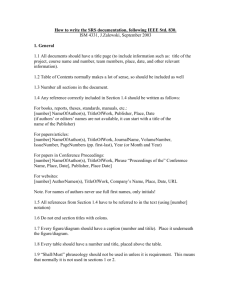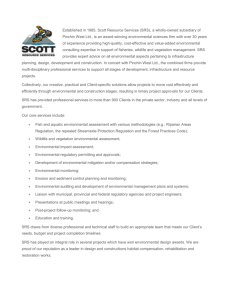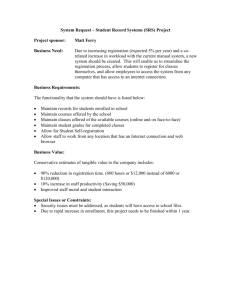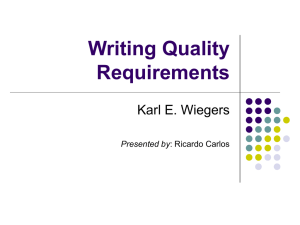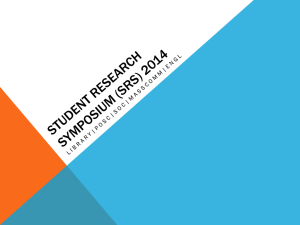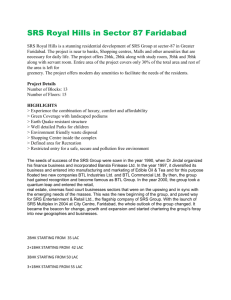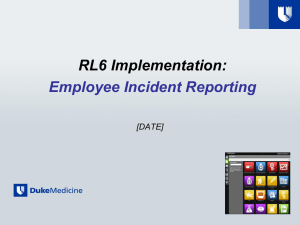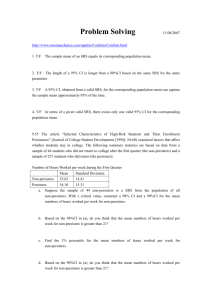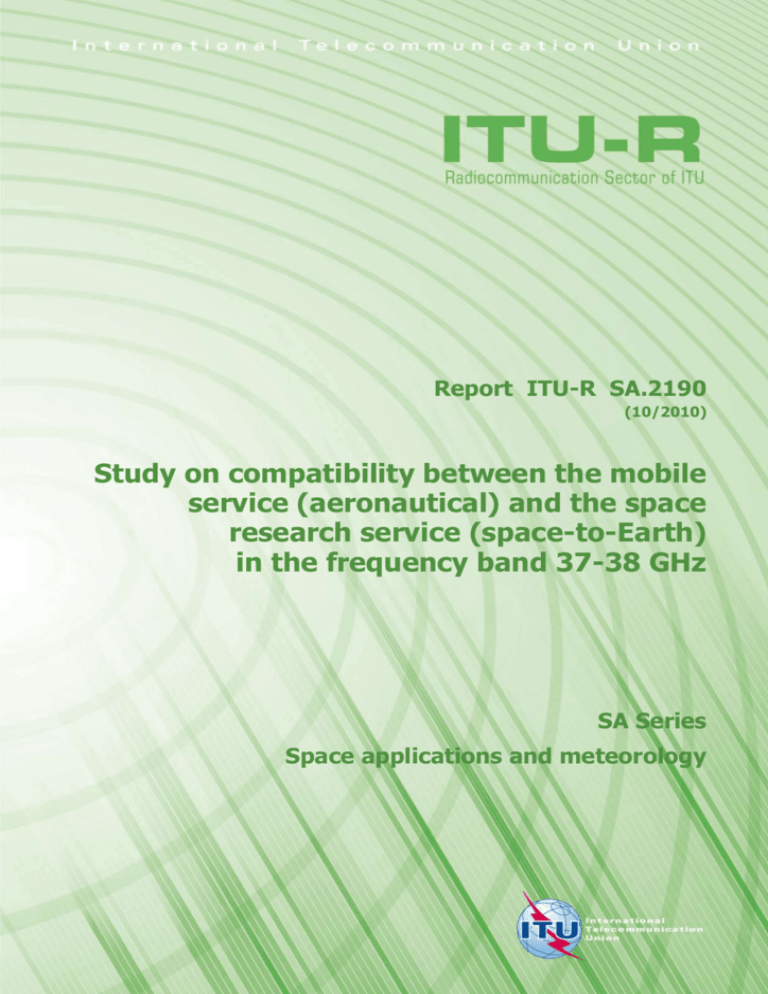
Report ITU-R SA.2190
(10/2010)
Study on compatibility between the mobile
service (aeronautical) and the space
research service (space-to-Earth)
in the frequency band 37-38 GHz
SA Series
Space applications and meteorology
ii
Rep. ITU-R SA.2190
Foreword
The role of the Radiocommunication Sector is to ensure the rational, equitable, efficient and economical use of the
radio-frequency spectrum by all radiocommunication services, including satellite services, and carry out studies without
limit of frequency range on the basis of which Recommendations are adopted.
The regulatory and policy functions of the Radiocommunication Sector are performed by World and Regional
Radiocommunication Conferences and Radiocommunication Assemblies supported by Study Groups.
Policy on Intellectual Property Right (IPR)
ITU-R policy on IPR is described in the Common Patent Policy for ITU-T/ITU-R/ISO/IEC referenced in Annex 1 of
Resolution ITU-R 1. Forms to be used for the submission of patent statements and licensing declarations by patent
holders are available from http://www.itu.int/ITU-R/go/patents/en where the Guidelines for Implementation of the
Common Patent Policy for ITU-T/ITU-R/ISO/IEC and the ITU-R patent information database can also be found.
Series of ITU-R Reports
(Also available online at http://www.itu.int/publ/R-REP/en)
Series
BO
BR
BS
BT
F
M
P
RA
RS
S
SA
SF
SM
Title
Satellite delivery
Recording for production, archival and play-out; film for television
Broadcasting service (sound)
Broadcasting service (television)
Fixed service
Mobile, radiodetermination, amateur and related satellite services
Radiowave propagation
Radio astronomy
Remote sensing systems
Fixed-satellite service
Space applications and meteorology
Frequency sharing and coordination between fixed-satellite and fixed service systems
Spectrum management
Note: This ITU-R Report was approved in English by the Study Group under the procedure detailed
in Resolution ITU-R 1.
Electronic Publication
Geneva, 2010
ITU 2010
All rights reserved. No part of this publication may be reproduced, by any means whatsoever, without written permission of ITU.
Rep. ITU-R SA.2190
1
REPORT ITU-R SA.2190
Study on compatibility between the mobile service (aeronautical)
and the space research service (space-to-Earth)
in the frequency band 37-38 GHz
(2010)
TABLE OF CONTENTS
Page
1
Introduction ....................................................................................................................
2
2
Single-entry analyses ......................................................................................................
2
2.1
Single-entry narrow-band transmitter mode .......................................................
5
2.2
Single-entry wideband transmitter mode ............................................................
5
2.3
Maximum AMS e.i.r.p. densities for single-entry case ......................................
5
2.4
Interference time duration...................................................................................
6
2.4.1
Static link considerations .....................................................................
6
2.4.2
Dynamic simulation .............................................................................
6
Interference to the planned SRS mission ASTRO-G .........................................
8
Multiple-entry analysis ...................................................................................................
11
3.1
Methodology summary .......................................................................................
11
3.2
SRS station parameters .......................................................................................
11
3.3
Air-traffic model parameters ..............................................................................
11
3.4
Simulation description and results ......................................................................
13
4
Compatibility of low power AMS systems with the PFD spectral density mask...........
15
5
Conclusions ....................................................................................................................
18
2.5
3
2
1
Rep. ITU-R SA.2190
Introduction
Earth stations for the space research service (SRS) have very sensitive receivers. To protect these
(deep-space and near-Earth) SRS earth stations from interference, the ITU has published protection
criteria in Recommendation ITU-R SA.1157 for the 2 GHz, 8 GHz, 13 GHz and 32 GHz bands.
For the 37-38 GHz band, Recommendation ITU-R SA.1396 gives the SRS earth station protection
criterion as −217 dBW/Hz not to be exceeded more than 0.1% of the time for unmanned missions
and 0.001% of the time for manned missions. This limit is applicable for both the deep-space and
near-Earth SRS missions.
The analyses in § 2 show that since the range of an aircraft transmitter is much less than the range
of SRS missions (see Table 1), interference from a transmitter in the aeronautical mobile service
(AMS) to an SRS earth station receiver can significantly exceed the SRS earth station protection
criteria.
TABLE 1
Typical slant ranges from an earth station
Slant range
(km)
Relative inverse
square loss
(dB)
14
0
LEO at 300 km altitude, 15° elevation
1 400
40
GEO
33 000
67
2 000 000
102
Aircraft at 12 km altitude, 60° elevation
Deep space mission at minimum distance
Recommendation ITU-R SA.1016 provided an example of a narrow-band aeronautical mobile
transmitter interfering with a space research earth station (space-to-Earth) (deep space) at
frequencies up to 32 GHz. Given an aircraft transmitter with maximum e.i.r.p. density of
10 W/4 kHz (equivalent to −26 dBW/Hz), antenna gain of 0 dBi, and altitude of 12 km, the results
in Annex 1 (see Table 3) of this Recommendation showed that the minimum interference received
by the SRS earth station would exceed the protection criteria. Therefore, the Tables of Frequency
Allocations in the ITU Radio Regulations have excluded aeronautical mobile in the frequency
bands 2.29-2.3 GHz, 8.4-8.5 GHz, 22.21-22.5 GHz and 31.5-31.8 GHz, where the mobile service is
co-allocated with the space research service. This Recommendation did not, however, consider very
low power AMS systems.
The following sections will present the results of compatibility studies for a single AMS transmitter
or multiple AMS transmitters for sharing the 37-38 GHz band by SRS and AMS.
2
Single-entry analyses
The interference from a single aeronautical mobile transmitter to the space research earth stations is
analyzed for a narrow-band (NB) mode and a wideband (WB) mode.
Rep. ITU-R SA.2190
3
For the narrow-band mode, the aircraft e.i.r.p. density is assumed to be 10 W/4 kHz, which is
equivalent to −26 dBW/Hz. For the wideband mode, the aircraft e.i.r.p. density is assumed to be
70 W/10 MHz, which is equivalent to −51.5 dBW/Hz. For both narrow and wideband modes, two
cases are analyzed:
Case 1
The aircraft altitude is 12 km and it is at 0-degree elevation relative to the SRS earth station,
with a transmit antenna gain of 0 dBi towards the SRS earth station. Furthermore, the SRS earth
station antenna is assumed to have a −10 dB gain in the direction of the aircraft, corresponding to a
boresight separation angle greater than 48° (using the antenna gain pattern given in
Recommendation ITU-R SA.509). This case represents the minimum interference from AMS
transmitter to the SRS earth station.
Case 2
The aircraft altitude is 12 km and it is at 60-degree elevation relative to the SRS earth station,
with a transmit antenna gain of 0 dBi towards the SRS earth station. Furthermore, the SRS earth
station antenna is assumed to have a 0 dB gain in the direction of the aircraft, corresponding to a
boresight separation angle of 19° (using the antenna gain pattern given in Recommendation
ITU-R SA.509). This case represents a more typical interference.
Note that in Recommendation ITU-R SA.1016, the interference analyses were done using Case 1
for the narrow-band mode only. Here we have extended the link analyses in Recommendation
ITU-R SA.1016 given for the frequency bands below 32 GHz to the 37-38 GHz band. Table 2 gives
the results for Cases 1 and 2 using the narrow- and wideband modes.
TABLE 2
Aeronautical mobile interference to space research service for narrow-band
and wideband modes at 38 GHz
Narrow-band
(NB) mode
Case 1
Case 2
Wideband
(WB) mode
Case 1
Case 2
Aeronautical mobile space station
Transmitter power (W)
10
70
Reference bandwidth (kHz)
4
10 000
Aircraft antenna gain toward victim (dBi)
0
0
Aircraft e.i.r.p. (dBW)
10
18.5
e.i.r.p. density (dBW/Hz)
–26
–51.5
Altitude (km)
12
12
Elevation (degrees)
0
60
0
60
Slant range (km)
391
14
391
14
Space loss (dB)
176
147
176
147
4
Rep. ITU-R SA.2190
TABLE 2 (end)
Narrow-band
(NB) mode
Wideband
(WB) mode
Case 1
Case 2
Case 1
Case 2
Victim antenna off-boresight angle (degrees)
≥ 48
19
≥ 48
19
Victim antenna gain toward interferer
(Recommendation ITU-R SA.509) (dBi)
–10
0
–10
0
Maximum received PSD (dBW/Hz)
–212
173
–237.5
–198.5
–20.5
18.5
SRS earth station
–217
Protection criterion (deep-space and near-Earth)
(Recommendation ITU-R SA.1396) (dBW/Hz)
Max received PSD exceedance above SRS
protection criterion (deep-space and near-Earth) (dB)
5
44
In Fig. 1, the received interference power spectral densities are plotted with respect to the aircraft
elevation angle for narrow- and wideband modes. The figure also shows the Cases 1 and 2 points,
which are analyzed in detail in Table 2.
FIGURE 1
Received power spectral density vs. aircraft elevation angle
for the narrow-band and wideband modes
–160
–170
Case 2
NB (SRS G = 0 dBi)
Received PSD (dBW/Hz)
–180
NB (SRS G = –10 dBi)
–190
Case 2
–200
WB (SRS G = 0 dBi)
–210
WB (SRS G = –10 dBi)
Case 1
–220
–217 dBW/Hz (SRS Earth station protection)
–230
Case 1
–240
–250
0
10
20
30
40
50
60
Aircraft elevation angle (degrees)
70
80
90
Rep. ITU-R SA.2190
5
In deriving the results shown in Fig. 1, we have used the parameters for the narrow- and wideband
AMS transmitter modes with the receive antenna gains of –10 dBi and 0 dBi. The assumed aircraft
altitude is 12 km. The figure also shows the deep-space earth station protection criterion for
comparison.
2.1
Single-entry narrow-band transmitter mode
For the narrow-band mode, Table 2 above shows that in Case 1, the interferences will exceed the
SRS protection criterion by 5 dB, whereas in Case 2, the interferences will exceed the SRS
protection criterion by 44 dB. These interferences far exceed the protection criterion of space
research earth stations for deep-space and near-Earth missions. Note that, for the narrow-band
mode, the minimum expected interference is above the SRS earth station protection for all aircraft
elevation angles (see Fig. 1).
2.2
Single-entry wideband transmitter mode
As shown in Table 2, for the wideband mode, we considered a possible aircraft transmission with
10 MHz bandwidth, at a carrier frequency less than 40 GHz, and with transmitter power of 70 W.
The e.i.r.p. density for this wideband mode is calculated to be –51.5 dBW/Hz. This is 25.5 dB lower
than the e.i.r.p. density of the narrow-band mode. As shown in Table 2, in Case 1, the interference
levels will be below the protection criterion by 20.5 dB, but in Case 2, they will exceed the
protection criterion by 18.5 dB. Note that, for the wideband mode, the minimum expected
interference is above the SRS earth station protection when the aircraft elevation angle is greater
than 19° (see Fig. 1)
2.3
Maximum AMS e.i.r.p. densities for single-entry case
To bound the extent of the sharing situation, it is necessary to calculate the best and worst-case
sharing scenarios. The interference power received at an SRS earth station is calculated by using the
free space loss and the minimum gain of the SRS earth-station antenna, which results in a best case
sharing scenario. By calculating this interference power received at different aircraft e.i.r.p. density
levels as a function of slant range, it is possible to determine the maximum e.i.r.p. density allowed
from the aircraft to satisfy the interference criteria. These results are in Fig. 2.
The maximum altitude of a typical aircraft is 12 km. If an aircraft is flying at an altitude of 12 km,
the minimum slant range would be 12 km. From Fig. 2 we see that for this range, the maximum
allowed aircraft e.i.r.p. density would be –60 dBW/Hz emanating from the aircraft. However, this
best-case sharing scenario does not take into account the aircraft interfering with the earth station’s
main beam. In practice, SRS earth stations may track satellites in near-Earth orbit, lunar orbit,
or deep-space missions, resulting in a wide variety of antenna pointing angles, and aircraft may fly
in any number of directions, altitudes and speeds. Under these circumstances, it is reasonable to
assume that the aircraft may be within the main beam of the SRS earth station antenna. Assuming
a boresight antenna gain of 80 dB, the previous static link analysis is repeated. Results of this
analysis are also shown in Fig. 2.
While an e.i.r.p. density of –60 dBW/Hz emanating from an aircraft is acceptable for the back lobe,
the power level received in the main lobe will exceed the interference criteria by 90 dB. Purely on
a static basis, in order to completely satisfy the interference power requirement for the SRS earth
station’s main lobe, an aircraft e.i.r.p. density of –150 dBW/Hz must not be exceeded, at an
aircraft’s maximum altitude of 12 km. Aircraft operating lower than a 12 km altitude will need
lower e.i.r.p. emissions to meet the interference criteria in both the SRS earth station’s main and
back lobes. Since aircraft position and SRS earth station antenna pointing direction are both
changing dynamically, the limit of aircraft’s e.i.r.p. should be determined statistically, using a
dynamic simulation.
6
Rep. ITU-R SA.2190
FIGURE 2
Max AMS e.i.r.p. densities for mininimum (–10 dBi) and maximum (80 dBi) SRS antenna gains
to meet the SRS earth station protection
0
NB-AMS transmitter
e.i.r.p. density = –26 dBW/Hz
AMS transmitter e.i.r.p. density (dBW/Hz)
–20
–40
Min SRS Earth station gain = –10 dBi
–60
WB-AMS transmitter
e.i.r.p. density = –51.5 dBW/Hz
–80
–100
–120
Max SRS Earth station gain = 80 dBi
–140
–160
–180
–200
0
50
100
150
200
250
300
350
400
Slant range (km)
2.4
Interference time duration
2.4.1
Static link considerations
In the narrow-band mode, as discussed in § 2.1, interference from a single aeronautical mobile
station is above the space research earth station protection criteria for all elevation angles of the
aircraft and for all pointing directions of the earth station antenna (see Figs 1 and 2). Therefore, the
interference is expected to exceed the SRS earth station protection criteria 100% of the time.
In the wideband mode, as discussed in § 2.2, the interference under the same geometry will be
25.5 dB weaker than the corresponding narrow-band mode. Therefore, for low elevation angles
(less than 19°) when the slant range is large the received interference PSD would be less than the
SRS earth station protection (see Figs 1 and 2). However, if the aircraft elevation is greater than 19°
the interference PSD would exceed the protection for all pointing direction of the SRS earth station
antenna. Using these facts, it is estimated that the interference levels would exceed the protection
criterion for about 70% of the time.
2.4.2
Dynamic simulation
The SRS earth station can track different types of missions, such as polar orbiting spacecraft,
manned spaceflight in Earth orbit, lunar missions, and deep-space missions. Each of these
applications requires different earth station requirements, and will involve different antenna
elevation, azimuth, and speed characteristics.
Rep. ITU-R SA.2190
7
Two simulation scenarios investigating the interaction between an aircraft and either a polar
orbiting lunar satellite or a polar orbiting satellite were used in order to calculate the interference
power received at the SRS earth station. The simulations consist of an earth station, the particular
SRS mission, and a single aircraft transmitter. Simulation configuration details are summarized in
Table 3.
TABLE 3
Dynamic simulation parameters
SRS earth station parameters
Latitude
40.4° N
Longitude
4.3° W
Antenna pattern
Recommendation ITU-R S.465-5
Antenna gain
80 dB
Antenna diameter
34 m
Antenna efficiency
55%
Lunar satellite parameters
(referenced to the Moon)
Altitude
50 km
Orbital period
2h
Inclination
90°
Non-GEO satellite parameters
Altitude
703 km
Orbital period
98.8 min
Inclination
98.2°
Aircraft parameters
Altitude
0-12.2 km
Slant ranges from SRS earth station
1-350 km
Elevation at SRS earth station
0°-90° (provided aircraft altitude is less than
12.2 km)
Aircraft elevation increment
1° (Slant range ≤ 100 km)
2° (Slant range > 100 km)
Data is collected in order to get a view of the interference caused by the aircraft transmitter.
The aircraft is initially placed at 90° elevation and a heading of 0° with respect to the earth station
for a particular slant range. Using data from § 2.3, an initial aircraft transmission e.i.r.p. density of
–60 dBW/Hz was chosen, and then the simulation is run over one year, the aircraft’s power is then
reduced and the simulation is re-run at the new power level, until the aircraft system meets the SRS
earth station protection criterion. Then the aircraft elevation is decreased, at the same slant range.
Only values with an aircraft altitude of 12.2 km or less are considered in this analysis. The process
is repeated for subsequent azimuth angles at 10° increments until a full circle has been completed,
for a particular slant range.
8
Rep. ITU-R SA.2190
Results of this simulation provide information based on a static aircraft and a dynamic SRS earth
station antenna. For each slant range the case that causes the most interference is selected. Figure 3
plots the relationship of aircraft e.i.r.p. density and slant ranges from 1 km to 350 km while meeting
the SRS earth station protection criterion for the manned spaceflight. The aircraft e.i.r.p. density
that conforms to the criteria at all slant ranges studied is –156 dBW/Hz. Figure 3 shows that, in
general, the maximum allowed e.i.r.p. density decreases as the slant range decreases.
FIGURE 3
Maximum aircraft e.i.r.p. density vs. slant range while meeting SRS earth station protection
–60
Polar non-GSO mission
Lunar mission
Aircraft e.i.r.p. (dBW/Hz)
–80
–100
–120
–140
–160
–180
0
50
100
150
200
250
300
350
Slant range (km)
The PFD spectral density received at the earth station is also calculated for the points selected in
Fig. 3. Due to the selection process to ensure that an aircraft’s transmission would not exceed the
SRS earth station protection criterion, the resulting PFD spectral density data is fairly similar along
all elevation angles, and vary slightly with range. The PFD spectral density received at an earth
station during the lunar orbiting mission simulation has a maximum value of –226.2 (dBW/Hz)/m2,
and a minimum value of –227.0 (dBW/Hz)/m2.
Similarly, the PFD spectral density received at the earth station during the polar orbiting mission
simulation has a maximum value of –226.2 (dBW/Hz)/m2, and a minimum value of
–227.1 (dBW/Hz)/m2.
2.5
Interference to the planned SRS mission ASTRO-G
A Space-VLBI satellite, named ASTRO-G, enables high-resolution celestial observations through
its onboard radio telescope. It is planned to be launched in 2012.
ASTRO-G conducts studies of regions where extreme physical conditions are encountered, and its
instruments are consequently designed to realize the following science goals:
i)
the structures and magnetic field configurations of accretion disks in nearby active galactic
nuclei (AGNs);
ii)
the mechanism of jet acceleration and collimation;
Rep. ITU-R SA.2190
iii)
iv)
v)
9
the motion of masers in galactic star forming regions;
the study of proto-stellar magnetospheres;
the structures and magnetic fields of accretion disks in active galactic nuclei.
To achieve an order of magnitude higher sensitivity for continuum sources, VLBI data needs to be
down-linked in real-time at 1 Gbit/s using the 37-38 GHz band. ASTRO-G follows
Recommendation ITU-R SA.1344 – Preferred frequency bands and bandwidths for the transmission
of space VLBI data.
Table 4 summarizes link performance when the ASTRO-G downlink has AMS transmitter
interference. As shown in the table, when ASTRO-G is at its apogee orbital position and the SRS
earth station tracks ASTRO-G in the zenith direction, link margin of 6.0 dB is secured.
However, as also shown in the table, when the AMS transmitter signal comes in the same direction
as ASTRO-G, the link margin degrades to –92.85 dB.
Link margin can be secured when the AMS transmitter signal is received with SRS antenna
boresight separation angle of 86°, which corresponds to a distance of about 172 km from the SRS
station. In this case, the time period when ASTRO-G is being interfered with is about 23 min for
flight speed of Boeing 747 (time calculation for distance of 170 km × 2).
The above analysis result is for the AMS transmitter narrow-band mode. For the wideband mode,
link margin can be secured until the boresight separation angle becomes more than 31°, where
distance from the SRS station is about 7.2 km with an interference time of about 1 min.
As the on-board data production rate of ASTRO-G is 1 Gbit/s, which is too large to store the data
on the on-board recorder, several SRS stations around the world are necessary for downlinking the
SVLBI data in real time. The SRS stations currently planed are Usuda in Japan, Yebes in Spain,
and one or two more sites in southern hemisphere, such as Australia and/or South Africa.
Interference with any of these stations jeopardizes the observations.
ASTRO-G will be placed in an elliptical orbit with an apogee height of 25 000 km above the
Earth’s surface and a perigee height of 1 000 km. The orbit period is about 7.5 h. Since ASTRO-G
will conduct VLBI observation over an orbital location of more than 5 000 km height above the
Earth’s surface when the SRS antenna motion is slow, ASTRO-G is vulnerable to the AMS
transmitter during this observation period in terms of both the time duration interfered and strength
of interference signal. When the SRS antenna tracks ASTRO-G at a lower elevation angle, the
duration of interference becomes longer and rain attenuation becomes larger, resulting in larger data
loss.
Also noted is that ASTRO-G establishes a continuous two-way phase link, measuring round trip
phase difference from the prediction. In this measurement, as the SVLBI system estimates the
onboard clock time by integrating two-way phase variation data, any break of the phase link results
in the necessity of resetting the timing system at the SRS station. Therefore, frequent short link
breaks may cause all the measurement data useless.
10
Rep. ITU-R SA.2190
TABLE 4
Interference from AMS transmitter into ASTRO-G downlink at 37-38 GHz
ASTRO-G to SRS station
Frequency (MHz)
37 536
ASTRO-G transmitter power (dBW)
12.0
ASTRO-G antenna gain (dBi)
38.6
ASTRO-G e.i.r.p. (dBW)
50.6
Includes feeder loss and pointing
loss
Distance (km)
25 000
Space loss (dB)
211.9
ASTRO-G at apogee and tracking
at EL = 90°
Polarization loss (dB)
0.4
Atmospheric loss (dB)
1.2
Includes rain loss
SRS earth station antenna gain (dBi)
62.0
Includes feeder loss
Pointing loss (dB)
0.4
Received signal level “C” (dBW)
–101.3
SRS receiver system noise
temperature (K)
104.0
N0 (dBW/Hz)
–208.4
Received C/N0 (dBW/Hz)
107.1
Required C/N0 (dBW/Hz)
101.1
Margin without interference (dB)
QPSK
6.0
Interference to SRS station (Aircraft in the same direction of ASTRO-G (worst case))
Aircraft transmitter power (dBW)
Narrow-band
Wideband
10.0
18.5
Aircraft antenna gain (dBi)
0.0
Slant range (km)
12.0
Space loss (dB)
145.5
SRS earth station antenna gain (dBi)
62.0
Aircraft received from same
direction of ASTRO-G
–73.5
–65.1
4
10 000
Interference PSD “I0” (dBW/Hz)
–109.5
–135.1
Received C/(N0 + I0) (dBW/Hz)
8.2
33.8
Required C/N0 (dBW/Hz)
101.1
101.1
QPSK
Margin (dB)
–92.9
–67.3
Worst case
Interference level (dBW)
Bandwidth (kHz)
Average power per 1 Hz
Rep. ITU-R SA.2190
11
TABLE 4 (end)
ASTRO-G to SRS station
Aircraft interference from boresight separation angle
Boresight separation angle from
zenith direction (degrees)
86
31
Angle when link becomes marginal
SRS earth station antenna gain (dB)
–10.0
–5.3
Gain corresponding to boresight
separation angle
Aircraft range to SRS station (km)
172
14
23 min
1 min
Time period of interference
3
Multiple-entry analysis
3.1
Methodology summary
The methodology used for multiple-entry study is basically a Monte-Carlo simulation.
The interference power produced at the SRS earth station input by all aircraft is calculated and
compared to the SRS protection criterion. Several experiments are done, with varying the aircraft
position, as well as varying the SRS earth station pointing direction. The percentage of time when
the criterion is exceeded is then calculated.
In order to have a uniform distribution of the pointing directions of the SRS station over the
hemisphere, the sky is divided in cells of equal solid angles, as depicted in the epfd methodology
widely used for radio astronomy in Recommendation ITU-R M.1583-1.
The aircraft are deployed on actual air-routes. Their position on these routes is chosen randomly.
3.2
SRS station parameters
In order to reuse simulation modules already developed and validated for the sharing studies
between AMSS and FS or RAS systems prior to 2003, an SRS station location in France was
chosen. The coordinates are:
Latitude: 48.5°
Longitude: 2°
It is recognized that France does not have any SRS deep-space station. However, the methodology
may be transposed to for example Spain, with the same results.
The antenna gain pattern shown in Fig. 4 is based on the Recommendation ITU-R SA.1811 (Ja gain
model), with an antenna diameter of 34 m, an efficiency of 0.7, and a surface tolerance value of
hRMS = 0.35 mm.
3.3
Air-traffic model parameters
The air-traffic assumptions are the same as in the sharing study between AMSS and FS and between
AMSS and RAS performed before 2003. Figure 5 shows the air-routes simulated.
12
Rep. ITU-R SA.2190
FIGURE 4
SRS earth station antenna pattern (d = 34 m, eff. = 0.7, hRMS = 0.35 mm)
80
70
60
Antenna gain (dBi)
50
40
30
20
10
0
–10
–20
10
–3
10
–2
–1
10
1
Offset angle (degrees)
2
10
3
10
10
FIGURE 5
Air-routes considered for simulation
52
51
50
49
48
47
46
45
44
43
42
–4
–2
0
2
4
6
8
Rep. ITU-R SA.2190
13
The total number of aircraft deployed is set at 50. Their altitude is randomly chosen up to 10 000 m.
3.4
Simulation description and results
The simulation developed consists of the following steps:
1.
Place a specific number of aircraft over a country on the selected air routes.
The interference study used 50 aircraft.
2.
Divide the sky into cells of approximately equal solid angles. The interference study used
2 334 cells.
3.
Choose a random SRS antenna pointing direction for each cell.
4.
Taking into account the AMS and SRS characteristics, compute the aggregate interference
power into the SRS station, using:
Nplanes
pfd (i )GSRS (i )2
I 10 log
4Lgas (i )
i 1
where:
pfd(i):
GSRS(i):
Lgas(i):
:
PFD spectral density generated at the SRS earth station location by aircraft i
assuming free space loss only ((W/Hz)/m2)
SRS earth station antenna gain in the direction of aircraft i (as a ratio)
atmospheric attenuation for aircraft i (as a ratio)
wavelength (m).
The PFD spectral density generated by each aircraft at the SRS earth station is calculated from the
aircraft elevation angle as seen from the SRS earth station and its altitude.
5.
Compare the interference power calculated in Step 4 with the SRS earth station protection
criterion (§ 3.2).
6.
Repeat Steps 1 to 5 to get a given number of experiments (at least 100 times in order to get
representative time statistics for unmanned missions, 2 000 times for manned missions).
7.
Determine for each cell the percentage of experiments where the SRS earth station
protection criterion has been exceeded and average it over all cells.
8.
Compare this number with the SRS percentage of time criterion.
Using these steps, it is determined that the PFD spectral density limit given below just meets the
–217 dBW/Hz interference PSD with 0.001% exceedence probability:
–174 – 10.6 ·
–227
(dBW/Hz)/m2
for
2
for
(dBW/Hz)/m
5
5 90
where is the angle of arrival of the radio-frequency wave (degrees above the horizontal). It is
plotted in Fig. 6.This limit relates to the PFD spectral density that would be obtained assuming
free-space loss and aircraft fuselage loss for the AMS transmitters that are inside the aircraft.
For the PFD spectral density limit given in Figs 6 and 7 shows an example distribution of the
interference power density over the sky divided into 2 334 cells of equal solid angle for one single
experiment.
14
Rep. ITU-R SA.2190
FIGURE 6
PFD spectral density limit to be met by each AMS transmitter at each SRS earth station
–170
–180
2
pfd level ((dBW/Hz)/m )
–190
–200
–210
–220
–230
20
10
0
30
40
50
60
70
80
90
Elevation angle (degrees)
FIGURE 7
Interference power (dBW/Hz) for one single experiment
90
80
–230
70
–235
Elevation (degrees)
60
–240
50
40
–245
30
–250
20
10
0
–255
0
50
100
150
200
250
Azimuth (degrees)
300
350
Rep. ITU-R SA.2190
15
In practice, for a complete interference analysis 2 000 experiments are performed, which gives
an overall number of 4 668 000 samples for the Monte-Carlo simulation.
4
Compatibility of low power AMS systems with the PFD spectral density mask
Although high power aircraft transmitters of the AMS system will cause excessive interference to
the SRS and FSS earth stations, it is necessary to assess whether very low power AMS transmitters
within an aircraft could meet the protection criteria of SRS, FSS and FS.
For example, the aviation industry is anticipating a growing demand for wireless avionics intracommunications (WAIC) systems to be installed on-board aircraft. These systems are envisioned to
be very low power, and are intended to support data, voice, and video communications between
various systems in an aircraft. They are not intended to provide air-to-ground, air-to-satellite, or airto-air communication. They will include wireless sensors located at various points throughout the
aircraft that monitor the health of the aircraft structure and many of its critical systems,
and communicate this information within the aircraft.
There are basically four types of WAIC applications.
–
High data rate for indoor applications (HI)
–
High data rate for outdoor applications (HO)
–
Low data rate for indoor applications (LI)
–
Low data rate for outdoor applications (LO).
Since the low data rate applications are limited to frequencies up to 10 GHz, Only the high data rate
applications are considered here. At 37 GHz the total power for HI WAIC applications would range
from 25 to 39 dBm, and the power spectral density from –8 dBm/MHz to 16 dBm/ MHz. Similarly,
the power spectral density for HO WAIC applications would range from –16 dBm/ MHz to
8 dBm/MHz.
Tables 5 and 6 give the e.i.r.p. density limits for an aircraft at 10 000 m altitude, derived from the
PFD spectral density mask defined in § 2, assuming respectively an indoor WAIC application (HI)
with a 20 dB fuselage attenuation, and an outdoor WAIC application (HO). Tables 7 and 8 give the
same for an aircraft at 6 000 m altitude.
Assuming a 0 dBi antenna gain for the WAIC transmitter, it appears that high data rate applications
would not be able to meet the PFD spectral density mask for elevation angles higher than 3 to 5°
depending on the cases.
As WAIC are supposed to be transmitting from take off to landing, it is clear that they will not meet
the PFD spectral density mask defined for the protection of FS, SRS and FSS.
16
Rep. ITU-R SA.2190
TABLE 5
e.i.r.p. density limit for HI WAIC at 10 000 m
Elevation
(degrees)
PFD spectral density
(dBW/Hz)/m2
Range
(km)
e.i.r.p. density
(dBm/ MHz)
0
–180
357
52.1
2
–198.8
198
28.1
4
–217.6
126
5.4
5
–227
105
–5.6
10
–227
56
–11.0
20
–227
29
–16.7
30
–227
20
–20.0
40
–227
16
–22.2
50
–227
13
–23.7
60
–227
12
–24.8
70
–227
11
–25.5
80
–227
10
–25.9
90
–227
10
–26.0
TABLE 6
e.i.r.p. density limit for HO WAIC at 10 000 m
Elevation
(degrees)
PFD spectral density
(dBW/Hz)/m2
Range
(km)
e.i.r.p. density
(dBm/ MHz)
0
–180
357
32.1
2
–198.8
198
8.1
4
–217.6
126
–14.6
5
–227
105
–25.6
10
–227
56
–31.0
20
–227
29
–36.7
30
–227
20
–40.0
40
–227
16
–42.2
50
–227
13
–43.7
60
–227
12
–44.8
70
–227
11
–45.5
80
–227
10
–45.9
90
–227
10
–46.0
Rep. ITU-R SA.2190
17
TABLE 7
e.i.r.p. density limit for HI WAIC at 6 000 m
Elevation
(degrees)
PFD spectral density
(dBW/Hz)/m2
Range
(km)
e.i.r.p. density
(dBm/ MHz)
0
–180
277
49.8
2
–198.8
133
24.6
4
–217.6
79
1.3
5
–227
65
–9.7
10
–227
34
–15.4
20
–227
17
–21.2
30
–227
12
–24.4
40
–227
9
–26.6
50
–227
8
–28.1
60
–227
7
–29.2
70
–227
6
–29.9
80
–227
6
–30.3
90
–227
6
–30.4
TABLE 8
e.i.r.p. density limit for HO WAIC at 6 000 m
Elevation
(degrees)
PFD spectral density
(dBW/Hz)/m2
Range
(km)
e.i.r.p. density
(dBm/ MHz)
0
–180
277
29.8
2
–198.8
133
4.6
4
–217.6
79
–18.7
5
–227
65
–29.7
10
–227
34
–35.4
20
–227
17
–41.2
30
–227
12
–44.4
40
–227
9
–46.6
50
–227
8
–48.1
60
–227
7
–49.2
70
–227
6
–49.9
80
–227
6
–50.3
90
–227
6
–50.4
18
5
Rep. ITU-R SA.2190
Conclusions
Emissions in the 37-38 GHz band from a single aeronautical mobile transmitter, operating with
narrow-band or wideband modulation under the assumptions contained in this Report, may severely
interfere with the space research earth stations (deep-space and near-Earth) used for space-to-Earth
communications. The studies related to ASTRO-G, lunar missions, as well as the multiple-entry
study also indicate that the aeronautical mobile transmitters may severely interfere with the space
research earth stations.
To satisfy the protection criteria, aeronautical mobile stations would need to avoid transmitting in
the 37-38 GHz band when they are in view of the space research earth stations. If such transmission
cannot be avoided, the PFD spectral density produced at the space research earth station by any
aircraft station would need to satisfy the PFD spectral density limit given in Fig. 6.
It should be noted that the PFD spectral density limit of –227 (dBW/Hz)/m² for high elevation
angles corresponds to an e.i.r.p. density level of –136 dBW/Hz at an altitude of 10 km, considering
free space loss only. If a typical WiFi transmitter radiating 100 mW in 20 MHz (equivalent to
–83 dBW/Hz) is deployed in the aircraft in this frequency range, then the aircraft fuselage
attenuation required for the protection of the SRS earth stations would be around 53 dB.
Low power aircraft transmitters such as WAIC will not be able to use the band without causing
harmful interference to the SRS earth stations.


